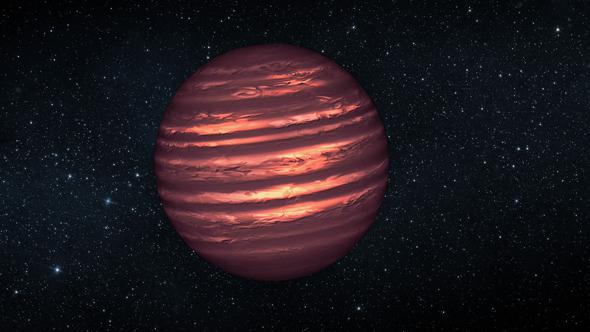Three recent news stories have come out, all dealing with exoplanets—alien worlds—that have something in common with Jupiter. All three stories are pretty cool, and I thought it would be fun to tell each in a separate, but related post. Not only that, I can tie the planet to the post number, too: For Part 1, it’s a planet that is all by itself in a crowd.
Just 150 light-years away from Earth lies a clump of stars, notable because they are young, and all about the same age: just 10 million years old. That may sound ancient, but remember that our Sun is more than 4.5 billion years old, and you can see why astronomers consider these newborns.
These stars were almost certainly born together, but they’re loosely bound together. Over time the group—called an association—will dissipate.
Still, groups of stars like this are useful, because all the stars are very nearly the same age and born from the same cloud of gas and dust. This removes (or minimizes) two variables that can affect how a star ages. By studying them we can better understand the life cycles of stars.
TW Hydrae, the nearby association in question is close enough to us that it appears rather large in our sky. Because there are thousands of stars in that part of the sky, astronomers observe them to try to determine which stars might be a part of the group and which aren’t.
While surveying stars in this area, astronomers found an interesting object dubbed 2MASS J11193254–1137466 (2MASS is the name of the survey, and the numbers represent its coordinates on the sky). Right away they were interested; the object is very red, and therefore likely to have a very low mass. More massive stars are hotter and bluer. Still, it has a temperature of about 1,500°C, warm enough to glow on its own in the infrared.
A spectrum quickly revealed the object was low mass indeed: It was classified as an L7, which is on the borderline between a true star and a brown dwarf, an object too low mass and cool to sustain nuclear fusion in its core.
That’s already very interesting, but it gets better. The astronomers took spectra of the object and found it was very young. When a brown dwarf first forms, it’s very hot due to all that matter falling onto it and slamming into it. The same is true for stars, and even planets. Planets and brown dwarfs cool over time, though, and their spectra change. When an object is young, it can fool you into thinking it’s more massive than it really is because it’s hotter and bluer.
2MASS J1119 was low mass, and young. But how young? The answer to that would reveal its true mass. And the key to that was whether or not it was a member of the TW Hydrae association or not. How can you tell?
One way is through what’s called kinematic dynamics. The stars in an association tend to move through space together, so looking at their velocities is a key factor in determining membership. The astronomers found that 2MASS J1119 does indeed have a velocity consistent with the group, and by applying a sophisticated statistical technique, they found that it’s very likely to be a member.
That’s exciting! We know the age of the association—10 million years—and that can be applied in the models of how objects like 2MASS J1119 cool to determine what its actual mass is. When this was done, it turned out it’s between four and eight times Jupiter’s mass.
That’s very small indeed, far lower than a star’s mass, and even lower than what a brown dwarf is. It’s actually a planet. Not only that, but its distance was found to be somewhat less than 100 light-years away, which means it’s on the near edge of the association, and all by its lonesome.
It’s not just a planet, it’s a rogue planet! It doesn’t orbit a star, but instead wanders the galaxy alone. It may have formed on its own, or it may have formed with a star and other planets, but got ejected somehow from the system. We think that most solar systems eject as many as half their planets through gravitational encounters, so there may be as many rogue planets between the stars as there are planets orbiting them.
A few such rogue planets have been found, and one is even closer to us than 2MASS J119. But the beauty of this one is that as a member of the TW Hydrae association, we can infer more of its properties than we otherwise might, extrapolating them from the properties of its siblings in the association. This planet is a test bed for models and hypotheses for how planets form and age.
And what will happen to it? Over millions of years, it will pull away from the group, and orbit the Milky Way on its own. It will cool, and eventually grow cold over billions more years.
I can’t help but wonder … what if it had moons that formed with it, and it was able to hold on to them as it moves away? With a hot object so close by, these moons would start off warm, then their surface would grow colder with time. But tidal forces might keep their interiors warm, as our Jupiter’s moon Io does, or Saturn’s Enceladus. That moon has a liquid ocean under its surface!
It’s not at all impossible that such exomoons orbit rogue exoplanets, watery oceans under solid ice crusts, with no real star to warm their surfaces. Could life arise there? And if so, if it evolved, grew intelligent, what myths would they weave to explain their happenstance? And how would their science develop, telling them the truth about the reality of the dark skies around them?
I started off thinking that this planet was singular, lonely. Maybe its story isn’t quite so simple.
